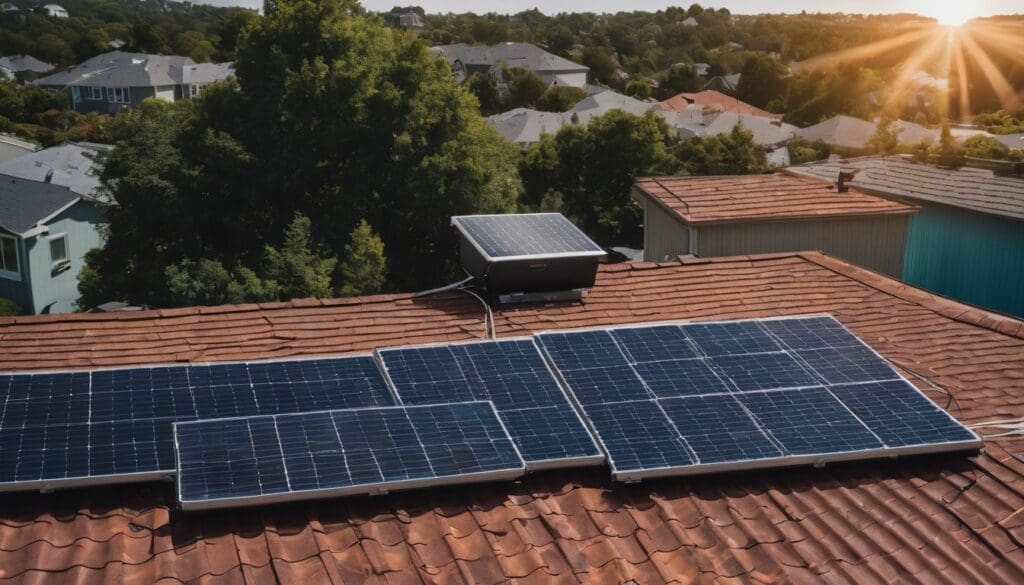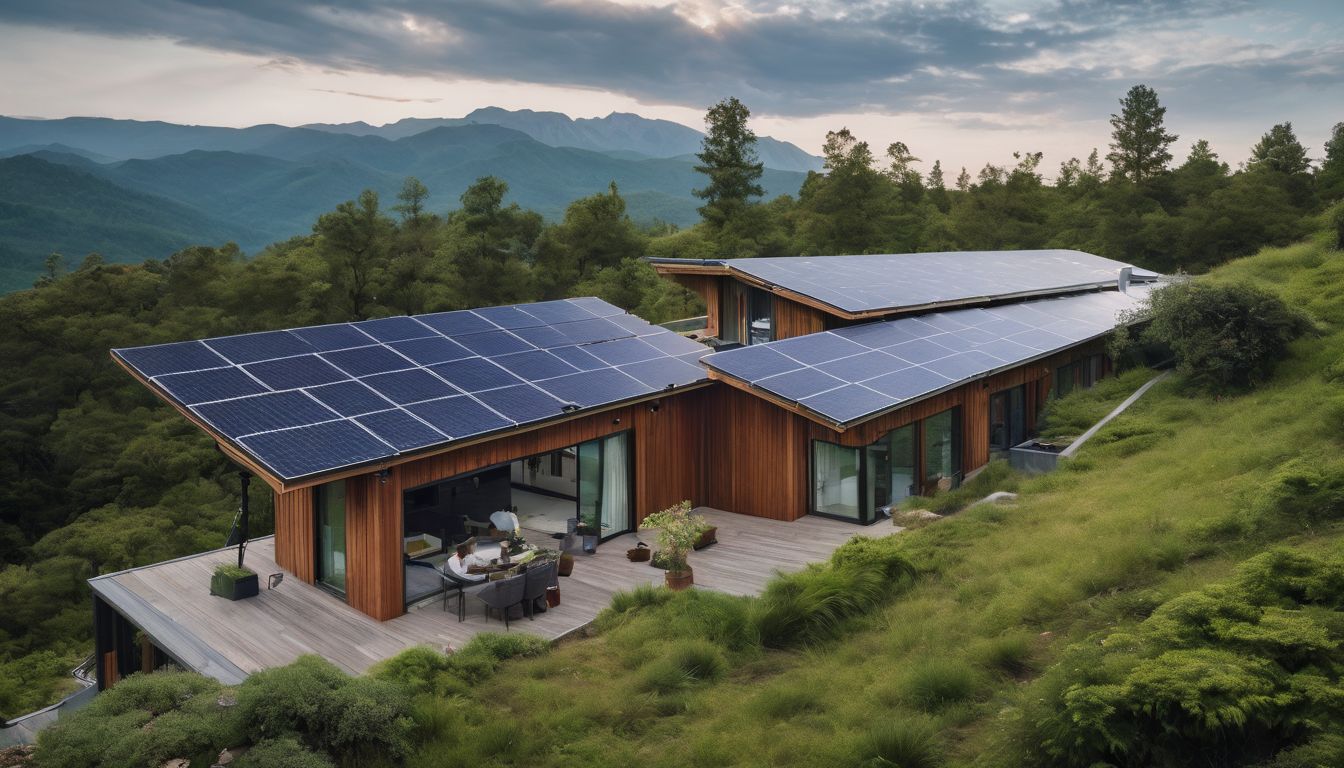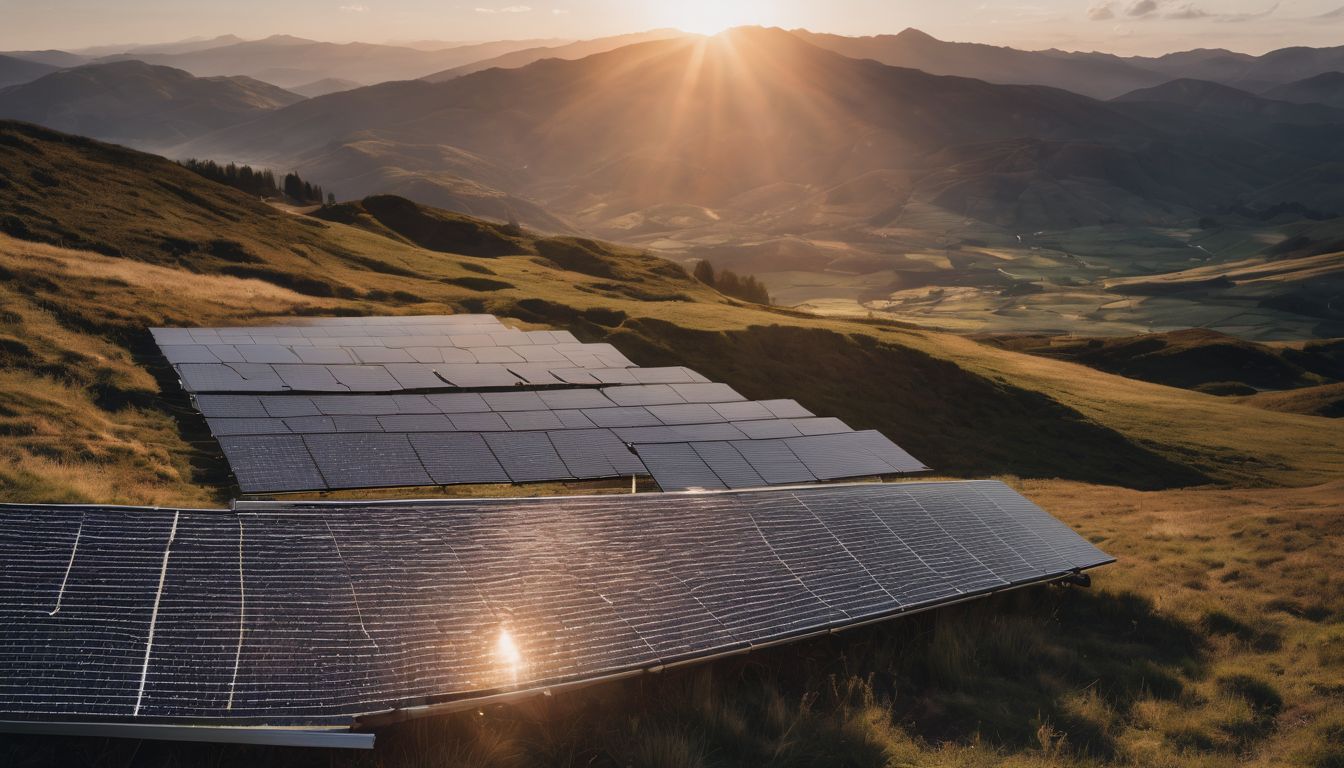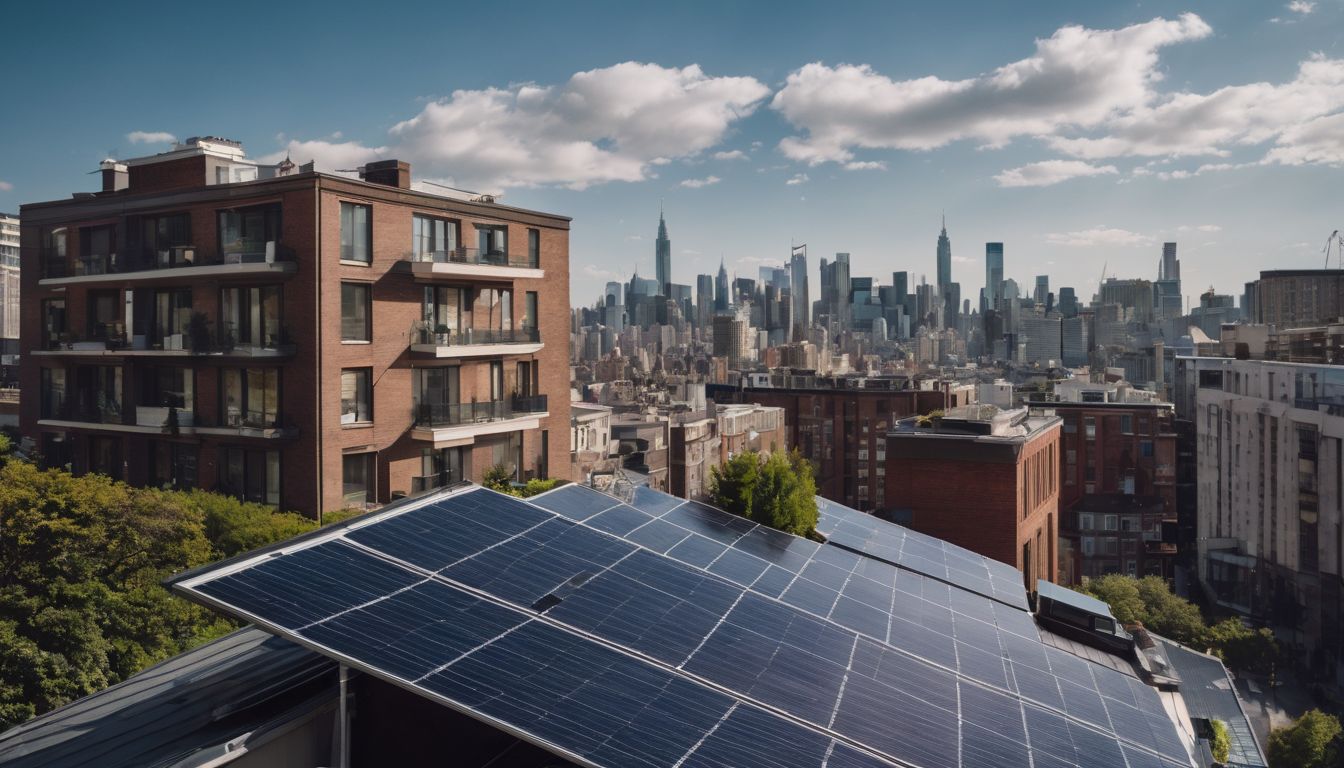Are your energy bills going through the roof? Solar energy can cut costs and reduce carbon footprints, a win-win for you and the planet. This guide shows easy solar projects that boost your home’s efficiency without breaking the bank.
Let’s harness the sun’s power today!
Key Takeaways
- Homeowners can use simple materials to build solar hot water systems, reducing reliance on conventional heating and saving money on bills.
- DIY solar projects like solar ovens, dehydrators, and air systems are cost-effective methods for using renewable energy at home.
- Solar panel installation can be done by homeowners with careful planning and understanding of the system components such as inverters and charge controllers.
- Solar – powered lighting and gadgets offer convenient, portable options for outdoor activities or emergency situations without increasing carbon footprint.
- Off-grid living is made possible with DIY solar power systems that include high-efficiency panels, deep cycle batteries, a charge controller, an inverter, and monitoring.
Understanding Solar Energy
Solar energy works by capturing sunlight and converting it into electricity or heat. The benefits of solar energy include reducing utility bills, lowering carbon footprint, and increasing energy independence.
How it works
Harnessing solar power starts with photovoltaic cells, which are the main components of solar panels. These cells convert sunlight directly into electricity through a process known as the photovoltaic effect.
Panels collect energy from the sun and send it to an inverter, transforming it from direct current (DC) to alternating current (AC), which powers your home appliances. Your solar system can also include batteries for storing surplus electricity or an energy monitoring system to track your usage.
Efficient energy management begins with understanding how much power you’re drawing from your renewable sources versus the grid. This knowledge empowers you to maximise your green energy use and supports sustainable living practices.
Next up, discover the benefits of integrating solar energy into your daily life.
Benefits of solar energy
Solar energy offers numerous benefits to homeowners, including the potential for significant cost savings on electricity bills. By installing solar panels, homeowners can harness renewable energy from the sun and reduce their reliance on traditional power sources.
In addition to financial savings, using solar energy helps to reduce carbon emissions and environmental impact, contributing positively to conservation efforts.
Another advantage of solar energy is its reliability and low maintenance requirements. Solar panels have a long lifespan and require minimal upkeep once installed, making them a practical and sustainable choice for homeowners looking to embrace renewable energy.
DIY Solar Projects for Home Heating
Looking to harness the power of the sun for home heating? Discover DIY solar projects like solar hot water systems, solar hot air systems, solar ovens, and solar dehydrators. These projects are not only cost-effective but also environmentally friendly.
Solar hot water system
Solar hot water systems use sunlight to heat water for domestic use. They are cost-effective and environmentally friendly.
- Solar Thermal Water Heater: A solar thermal water heater utilises sunlight to heat water in a collector, which is then stored in an insulated tank for later use.
- Solar Hot Water Panels: These panels absorb sunlight and convert it into thermal energy to heat water for household purposes.
- Solar Water Heating Kits: DIY solar water heating kits are designed for easy installation, providing an affordable way to harness solar energy for hot water needs.
- Passive Solar Water Heater: This system uses natural circulation or convection to circulate water through the collector and storage tank without the need for pumps or controllers.
Solar hot air system
The solar hot air system uses sunlight to heat air for various purposes. It is a simple and cost-effective way to harness solar energy at home.
- Solar Air Heater: Utilise a solar air heater to warm up the air using sunlight, which can then be used for space heating inside the house or other applications.
- Solar Air Collector: Construct a solar air collector using materials like aluminium cans or black painted metal sheets to absorb and transfer heat into the air, providing a sustainable heating solution.
- Solar Air Ventilation: Install a solar-powered fan in the attic or living spaces to circulate the heated air, reducing reliance on conventional heating methods and saving energy.
- Solar Air Drying System: Build a solar hot air drying system for drying clothes, herbs, fruits, or vegetables effectively without consuming electricity.
Solar oven
Transitioning from solar hot air systems to solar ovens, harness the sun’s energy for cooking and baking with a DIY solar oven using the following methods:
- Construct a solar oven using simple materials such as cardboard, reflective insulation, and a transparent cover, directing sunlight into the box to achieve high temperatures for cooking.
- Consider creating a parabolic solar cooker by shaping reflective material into a curved dish, concentrating sunlight onto a cooking vessel at the focal point.
- Utilise a panel cooker design comprising multiple reflective panels that fold around a pot or pan to capture and retain heat for efficient cooking.
- Build an evacuated tube solar cooker by placing food within evacuated glass tubes to trap heat from sunlight, allowing for slow and controlled cooking.
- Experiment with various designs and materials to optimise the functionality of your homemade solar oven while reducing reliance on conventional cooking methods.
Solar dehydrator
You can easily create a solar dehydrator to preserve fruits, vegetables, and herbs while reducing energy consumption. Here’s how to build one:
- Using a wooden frame, construct a box that has a slanted glass or plastic cover on top.
- Inside the box, place wire or mesh trays to hold the produce.
- Position the dehydrator in direct sunlight for optimal drying.
- Ensure good airflow by adding vents or openings to the sides of the box.
DIY Solar Projects for Homeowners
Get ready to harness the power of the sun with DIY solar panel installation, solar lighting and other solar-powered gadgets for your home. Dive into the world of solar energy projects and make your home more sustainable.
Read on to discover how you can take advantage of solar power for your home!
Solar panel installation
To install solar panels, start by determining the most suitable location for maximum sunlight exposure. Next, install mounting brackets securely onto the roof in accordance with local regulations. Connect the panels and wiring to an inverter to convert the solar power into usable electricity. Lastly, connect the inverter to your home’s electrical system to start harnessing solar energy efficiently. Remember to consult with a professional if needed during installation to ensure safety and optimal performance.
Solar lighting
After installing solar panels, you can add solar lighting to brighten up your home and garden.
- Illuminate pathways and gardens with solar-powered pathway lights or bollard lights. These fixtures charge during the day and light up at night, providing an eco-friendly and cost-effective way to light outdoor spaces.
- Use solar string lights to create a warm and inviting ambiance on your patio or in your garden. These can be wrapped around trees, shrubs, or pergolas, adding charm to outdoor gatherings without increasing your carbon footprint.
- Install solar wall lights near entrances for added security and convenience. Motion-activated solar wall lights are ideal for deterring intruders and providing illumination when you arrive home after dark.
- Light up sheds, garages, or other outbuildings with a solar-powered shed light. These easy-to-install lights are perfect for illuminating workspaces or storage areas without the need for expensive electrical wiring.
- Add decorative solar lanterns to your outdoor spaces for a touch of style while also reducing energy consumption. These versatile lights come in various styles and can be hung from branches, hooks, or shepherd’s crooks.
- Enhance the safety of stairways and decks with solar step lights that automatically turn on at dusk to guide you safely through these areas without increasing your electricity bill.
- Create an inviting atmosphere in your home using indoor solar lighting options such as solar desk lamps or table lamps that harness sunlight during the day for use at night.
Solar toys and gadgets
Solar toys and gadgets are fun and practical ways to harness solar power for everyday use.
- Solar-Powered Toys: From educational kits to remote-control cars, solar-powered toys are a great way to introduce renewable energy concepts to kids while having fun.
- Solar-Powered Chargers: Portable chargers equipped with solar panels provide a convenient way to charge devices on the go, reducing reliance on traditional power sources.
- Solar-Powered Backpacks: These innovative backpacks have integrated solar panels that can charge electronic devices while you’re on the move, making them ideal for outdoor activities or travelling.
- Solar-Powered Garden Decorations: Decorative lights, fountains, and other garden ornaments powered by solar energy are not only eco-friendly but also add charm to outdoor spaces without increasing electricity bills.
Solar charging stations
Transitioning from solar toys and gadgets to solar charging stations, homeowners can also consider setting up solar-powered charging stations for their electronic devices. These stations are convenient and environmentally friendly, providing a sustainable way to keep gadgets powered. Here are some solar charging station options to consider:
- Solar USB chargers: Compact and portable, these chargers harness solar energy to power smartphones, tablets, and other USB-compatible devices. They are ideal for outdoor activities or travel.
- Solar backpacks: Equipped with built-in solar panels, these backpacks capture sunlight to charge electronic devices on the go. They are practical for commuters and outdoor enthusiasts.
- Solar-powered outdoor outlets: These weather-resistant outlets convert sunlight into electrical power, allowing users to charge multiple devices simultaneously in their outdoor spaces.
- Solar-powered phone cases: Designed to fit various smartphone models, these protective cases come with integrated solar panels for convenient on-the-go charging.
- Solar-powered lanterns with USB ports: These versatile lighting solutions also feature USB ports for charging mobile devices while providing illumination in outdoor settings.
- Solar-boosted power banks: Combining traditional battery storage with integrated solar panels, these power banks allow users to charge their devices even when they’re away from direct sunlight.
Solar Power for Emergencies and Off-Grid Living
When it comes to emergencies or off-grid living, solar power can be a reliable source of backup electricity. Whether you’re preparing for a power outage or living off the grid, DIY solar projects can provide you with the energy independence you need.
Backup power for emergencies
In the event of emergencies, having backup power is essential. Solar power offers a reliable solution for emergency situations. Here are DIY solar projects for backup power:
- Solar-powered generator: Build a portable solar generator to keep essential devices running during power outages.
- Solar-charged battery bank: Construct a battery bank charged by solar panels for storing energy to use during emergencies.
- Solar lanterns and flashlights: Create solar-powered lighting solutions to illuminate your home when the grid is down.
- Solar phone charger: Make a solar-powered charger to keep communication devices powered up during emergencies.
Off-grid solar systems
Off-grid solar systems provide reliable electricity in remote areas. They are sustainable and reduce reliance on traditional grid systems. These systems include solar panels, batteries, charge controller, and an inverter.
- Solar Panels: Off-grid systems require high-efficiency solar panels to generate sufficient power.
- Batteries: Deep cycle batteries store excess electricity generated during the day for use at night.
- Charge Controller: It regulates the flow of energy from the solar panels to the batteries to prevent overcharging.
- Inverter: This device converts DC electricity from the solar panels and batteries into AC electricity for use in the home.
- Power Monitoring: Implementing a monitoring system is important to ensure efficient use of energy and monitor battery levels.
DIY solar-powered generator
Create your own solar-powered generator with these simple steps. Use a solar panel to capture sunlight and convert it into electricity. Connect the panel to a charge controller, which regulates the voltage and current going to the batteries. Wire the charge controller to deep cycle batteries for energy storage. Include an inverter to convert the stored energy from direct current (DC) to alternating current (AC). Attach outlets to the inverter for powering devices, making it a versatile backup power source for emergencies.
Conclusion
In conclusion, DIY solar projects offer homeowners a sustainable and cost-effective way to harness the power of the sun. Solar technology provides clean energy for heating, lighting, and powering various gadgets around the home.
Whether it’s installing solar panels or creating solar-powered appliances, these projects are not only environmentally friendly but also empower homeowners to take control of their energy consumption.
With the availability of DIY kits and resources, embracing solar power at home has never been easier.
FAQs
1. What are DIY solar projects for homeowners?
DIY solar projects for homeowners are home improvement tasks you can do by yourself to incorporate solar technology into your house, like installing solar panels or building gadgets powered by the sun.
2. Can I install my own solar power system at home?
Yes, with some knowledge of DIY and electrical systems, you can take on a project like a DIY solar panel installation for your home or create other solar-powered appliances.
3. Are there any easy DIY Solar electric projects beginners can try?
Absolutely! Beginners can start with small-scale and simple DIY projects such as setting up a basic solar electric system to power lights or charging stations for devices.
4. How do I determine the right size for my home’s DIY Solar power system?
For proper sizing of your DIY home solar power system, calculate your energy needs and review guidelines on matching those requirements to ensure sufficient power from your setup.
5. Is it possible to monitor how much energy my DIY Solar project generates?
Definitely! You can integrate a monitoring component within your sun-driven project that will allow you to keep tabs on exactly how much energy is being generated and used in real-time.





